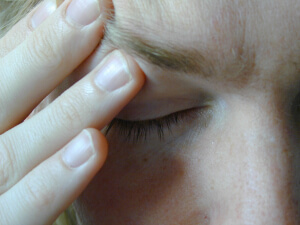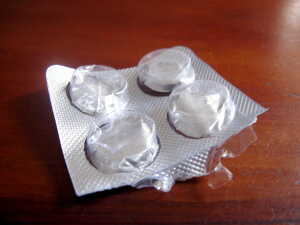This isn’t what I intended to write about; in fact, I’m in the middle of a series on the gut. However, the series has been derailed briefly, because I have been derailed, I hope briefly, by one mother of a headache.
 Three times in my life, I’ve been in so much pain that I have not even felt like a human. One was during the birth of my second child; he was turned around in such a way that there was tremendous pressure on my spine, and I couldn’t even talk. Seriously, I was reduced to moaning sounds like an animal. But this is a men’s health website, so I’ll spare you that story and move right to the other two times, which have been migraines. Actually, the migraine I’m going to talk about is the one I’m getting over as we speak.
Three times in my life, I’ve been in so much pain that I have not even felt like a human. One was during the birth of my second child; he was turned around in such a way that there was tremendous pressure on my spine, and I couldn’t even talk. Seriously, I was reduced to moaning sounds like an animal. But this is a men’s health website, so I’ll spare you that story and move right to the other two times, which have been migraines. Actually, the migraine I’m going to talk about is the one I’m getting over as we speak.
There are people who suffer from migraines and spend more days in pain than not. I am not one of those people, and usually, if I get a migraine, it goes away after a while and has an attributable cause. There are a bunch of known dietary triggers for migraines, including chocolate, aged cheeses, soy, and vinegar; caffeine; alcohol (red wine, beer, sherry and vermouth); food additives like MSG (monosodium glutamate) and hydrolyzed vegetable protein (HPV); nitrates (preservatives) found in hot dogs, pepperoni, jerky, lunch meats, and other smoked or preserved foods; tannins, found in tea, red wine (again with the red wine!), cider, and red-skinned fruits like apples and pears; sulfites (this is another preservative), found in dried fruits and red and white wine; the artificial sweetener, aspartame (NutraSweet and Equal).
This is not a complete list, but it goes along with what we’ve been talking about recently, that sometimes food can make you sick. Here’s something to think about: If you think something in your diet is making you sick, try giving it up for three weeks. Just one category at a time (like, dairy foods) – otherwise, you won’t know which thing you gave up was making you feel bad. We will talk more about this in the future, I just wanted to get this in there.
But it’s not always diet. There are numerous other triggers for migraines, and I have three of them: stress, fatigue, and dehydration. All three of them kicked in and that’s what started my recent 12-day trip to hell. So what I want to talk to you today is in the headache category, and it’s certainly a migraine, but to a certain degree, it was also self-inflicted and needlessly prolonged. It started for me on Mother’s Day weekend; our choir at church did three back-to-back concerts that might not have fazed a hardier person, but they knocked me on my rear end. So that was the precipitating factor. But what I did next escalated it to the extent that on the worst day, yesterday, I was seriously considering going to the emergency room.
The first thing I did, some of you men reading this may well identify with: I denied it. I thought, “This is not a migraine.” I had too much to do to deal with a migraine. I had to keep going. So I started taking Advil. This is by no means any indictment of Advil; it is a fine product. I just overused it. I started taking two, and then four a day. The headache would go away, and I would be able to get some work done, plug away at my various writing projects, chauffeur my youngest child, walk the dogs, do the housework, etc. Then it would come back.
 I failed to make the connection that this was one prolonged event.
I failed to make the connection that this was one prolonged event.
In fact, I even joked about my daily headache, and I thought if I could just make it to the weekend, or to bedtime, or a break in the on-the-run schedule, surely it would get better. By Day 10, I was up to six Advils a day, and the headaches kept coming back and were getting worse. I now know that this was a series of rebound headaches. Other symptoms of rebound headaches can include irritability, difficulty concentrating, restlessness, nausea, memory problems, and lack of energy. In my defense, you don’t do your best thinking when you’re having a migraine, so maybe that’s why it took me so long to figure it out.
In my case, the headache was a vascular one; severe pain on my right temple and a big-ass pulse that throbbed visibly (in fact, my right temple freakily stuck out more than my left).
What I should have done.
I should have realized that this was a migraine and taken actual migraine medicine to knock it out immediately. I actually have a prescription for Frova, a very effective drug that probably would have worked better, had I taken it sooner. But the thing had gotten so out of hand, it was hard to rein it back in. I took one on the evening of Day 10, and it got better. Day 11, it came back. I took another one. It helped, but didn’t stop it. By this point, I had wised up to the ibuprofen (Advil), so I tried acetaminophen (Tylenol) plus caffeine. This helped a little, but not enough.
Then, my wonderful daughter stepped in. She has done a lot of research on natural remedies, and I want to share some of these with you. Now, before you make some judgment and say, “Here we go, one of these crunchy granola types, she’s going to tell me to peel some willow bark and boil it.” Not at all, and shame on you!
What I am saying is, “Here are some more weapons for your arsenal. Try any and all of them, because the headache is your enemy, and you need to confuse it, so you can disarm it.”
All of these treatments did something very important: They diverted blood flow away from the headache.
This strategy is your new best friend. This is what you must do, whether it’s through prescription remedies, over-the-counter items, or complementary medicine (natural remedies). I think it’s a good idea never to rely on one treatment to take care of you and make it all better. There’s something to be said for the kitchen-sink approach:
Go after it with all you’ve got.
The first thing that helped: Peppermint oil. Rubbed on the temples, but I dabbed it all over my face. (Note: Peppermint oil can be irritating to the skin, so I probably shouldn’t have put it all over my face. Now it looks like my face is chapped in various places, but the pain is better, so I don’t even care.) Peppermint oil contains menthol. Menthol cools. It counteracted the heat and temporarily dulled the pain in my temple. I blessed it; I was so grateful to that peppermint oil.
Thinking the menthol was a good thing, I got out some Icy Hot and put it all over my back. Icy Hot has menthol and menthol salicylate, so it cools the skin and also causes a warming sensation that relaxes the body. Basically, it distracts your brain from the pain. If I’d had any capsaicin (an ingredient in chili peppers, this warms the body and relieves pain, too), I would have put that on, as well. Not on my head, but on my back or shoulder. Again, just an effort to divert the blood flow and confuse the pain sensors.
The most helpful thing: 15 minutes soaking my feet in very hot water with Epsom salts. This had several benefits. One, Epsom salts contain two helpful elements: magnesium and sulfate (not to be confused with sulfites, the food preservative mentioned above). Deficiencies in both of these can cause headaches. Magnesium is hard to absorb through the stomach, mainly because it’s also a laxative. But you can absorb it just fine through the skin in an Epsom salt footbath. The salts help draw out toxins from the body, too. But the biggest thing is, if it’s just as hot as you can stand it, this diverts blood flow from the headache in a big way. A hot shower helps do this, too; it would also have helped if I had put my hands in the hot Epsom salt water instead of my feet. (Have you ever had a migraine and noticed that your hands are cold? That’s because all the blood flow is in your head!) The effect there is like taking the oxygen away from a fire; without fuel, it can’t keep burning.
Through this combination of remedies, I have turned the corner on the headache. I did not go to the ER, I did not call my doctor and get another high-powered medicine. Maybe I should have, but again, when there’s something wrong with your head, you can’t think too well.
What have I learned?
 Do I think you shouldn’t use over-the-counter headache remedies? Of course not. Acetaminophen is good, particularly with caffeine and/or aspirin added. It is odd that caffeine can trigger a migraine and is also used to treat one, but there you go. Ibuprofen is good. Prescription drugs are good. Natural remedies are good. But I truly believe you have to mix it up.
Do I think you shouldn’t use over-the-counter headache remedies? Of course not. Acetaminophen is good, particularly with caffeine and/or aspirin added. It is odd that caffeine can trigger a migraine and is also used to treat one, but there you go. Ibuprofen is good. Prescription drugs are good. Natural remedies are good. But I truly believe you have to mix it up.
Have you ever watched a football game when the quarterback keeps doing the same play over and over – even though it’s not working? And you’re yelling at the TV, “Mix it up, moron!” Any pain reliever can cause a rebound headache if you use too much of it. This includes migraine medications, and especially opiates (Tylenol with Codeine, for example).
If you have more than two headaches a week, if you need to take pain medication for your headache more than twice a week, if the recommended dose doesn’t get it, or if your headaches are getting worse or lasting longer, go see a doctor. But also remember: You may be having rebound headaches. Mix up your treatment approach, and try to limit the fuel for the fire by diverting the blood flow. Confuse the enemy.
In addition to the book, I have written about prostate cancer on the Prostate Cancer Foundation’s website, pcf.org. The stories I’ve written are under the categories, “Understanding Prostate Cancer,” and “For Patients.” I firmly believe that knowledge is power. Saving your life may start with you going to the doctor and knowing the right questions to ask. I hope all men will put prostate cancer on their radar. Get a baseline PSA blood test in your early 40s, and if you are of African descent, or if cancer and/or prostate cancer runs in your family, you need to be screened regularly for the disease. Many doctors don’t do this, so it’s up to you to ask for it.
©Janet Farrar Worthington
